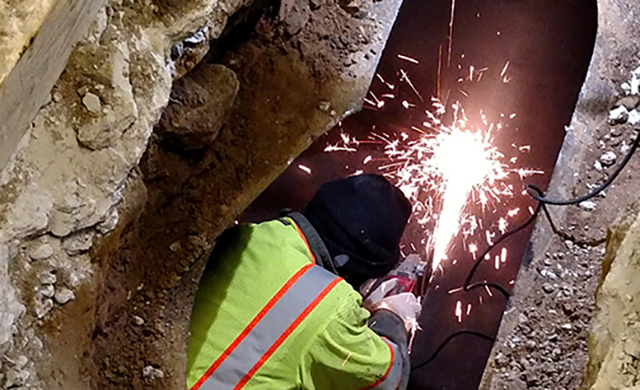
29 Apr Underground Storage Tanks: What Homeowners Need to Know
If you are a homeowner and you think you may have an older underground storage tank (UST) on your property, this article explains why USTs could be a problem and the best ways to deal with them.
Why Underground Storage Tanks May be an Issue
Underground storage tanks installed from approximately 1940-1995 were thin-walled and prone to corrosion and perforation. Many tanks manufactured in the past 20 years or so are much improved, but even the highest quality underground fuel tanks must be installed in accordance with the manufacturer’s directions to ensure safety. In New Jersey, residential heating oil tanks are non-regulated. Thus, proper installation is dependent solely on the manufacturer’s directions and guidance and the expertise of the company performing the installation.
Categories of Homes with USTs
Homes with underground storage tanks fall into one of several categories, each of which presents a separate set of circumstances:
- Homes with an active UST installed prior to 1995
- Homes with an active UST installed after 1995
- Homes for sale with an active UST
- Homes with a UST that is no longer in service but still contains oil
- Homes with a UST that has been emptied of oil and (ostensibly) closed in place
- Homes with a UST that was previously removed from the ground and properly disposed
- Homes with aboveground storage tanks (ASTs)
Homes with an active UST installed prior to 1995
Most pre-1995 fuel tanks don’t leak. But, despite the odds, if an older UST is not addressed now, someone else will have to address it in the future. And it will certainly become an issue if the homeowner decides to sell a home with an older buried fuel tank.
Older USTs can be closed in place or removed. Closing an oil tank in place is perfectly legal with proper documentation that demonstrates a discharge has not occurred. However, this option is not recommended, because the tank remains in the ground and may raise questions down the road. Proof that the tank did not leak will need to be presented. And, even with proof, potential buyers may remain wary. When a tank is removed, it is gone for good, taking the worry with it.
To close an underground storage tank in place, it first needs to be dug up, opened, pumped out, and cleaned. The UST must then be inspected for the presence of holes or a discharge. Then, even though not required, ESA strongly advises taking samples through the bottom centerline of the tank. If the samples are clean, the tank will need to be filled with certified clean soil, sand, and/or concrete. Once this is done, the contractor or consultant should provide a report with complete documentation (receipts, construction permit, laboratory results, photographs, etc.) demonstrating that the tank was closed per municipal and state regulations and that there was no impact to the soil. When the house is sold, the report should remain with the property as proof that the tank was properly closed in place and no longer poses an environmental threat.
Homes with an active UST installed after 1995
Preferably, product literature and specifications for the UST will have been retained, as well as construction drawings or as-builts (that include photographs) taken during the installation. The goal is to establish that the fuel tank was installed in accordance with current standards and is safe and secure. Absent this form of confirmation, the procedures described in the previous section may be required to prove no environmental hazard exists.
Homes for sale with an active heating oil tank
It is always preferable to address underground storage tanks before putting a house on the market. Evidence of a leak may include water in the tank or a recurring service problem with the oil burner. If a potential buyer wishes to test the UST for leaks, they should be allowed to do so at their expense. If the tank is sound, nothing further needs to be done. But if a leak is discovered, there is an obligation on the homeowner to act. This means an environmental consultant, such as ESA, should be called.
Homes with a UST that is no longer in service but still contains oil
An out-of-service buried oil tank is an accident waiting to happen. When oil remains in a tank that’s not in service, it is unlikely that a leak will be noticed. The longer a tank remains in the ground, the more likely a discharge will occur. Moreover, because there is an obligation on the part of the homeowner to disclose such information during a sale, ESA suggests that the owner remove the UST and document the removal well in advance of a potential deal.
Homes with a UST that has been emptied of oil and (ostensibly) closed in place
On a recent project, ESA was called to remove a UST that had been abandoned in place 15 years prior. A potential buyer sampled the tank and found levels of petroleum that were elevated, yet below actionable levels. Regardless, the buyer wanted the tank removed and the soil tested. During the extraction, it was discovered that the tank was twice as large as the homeowner originally reported. However, the tank was correctly closed in place, and ESA’s soil samples confirmed that the UST discharge did not impact soil above remediation standards. Thus, no remediation was needed. Had the contractor taken samples through the center line of the oil tank and the homeowner retained the report, the additional work required to remove the tank and re-test the soil could have been avoided. And the risk of losing a potential buyer would have been mitigated had the UST been addressed prior to listing the home for sale.
Homes with a UST that was previously removed from the ground and properly disposed
One of the most frustrating mistakes we see as an environmental consulting firm working on residential properties is when a homeowner has satisfactorily removed a UST from the property but has no documentation to prove the tank did not leak. Upon selling such a property, if a buyer’s attorney demands proof, the homeowner now has no choice but to conduct a soil investigation.
This scenario can be completely avoided if the vendor who removes the tank takes a soil sample and provides a report documenting all the removal activities. This is ESA’s standard procedure for residential tank removals. With ESA’s report, the homeowner can provide the buyer’s attorney with proof that eliminates this potential objection to the sale.
Homes with above ground storage tanks (ASTs)
Homeowners often feel a false sense of security when their oil is stored in an AST. Because ESA has had experience with problematic ASTs, the following advice may prove useful:
- It is preferable to house an AST indoors. If it must remain outdoors, be sure that it rests on a poured concrete pad to provide a firm and stable platform.
- Be sure the AST’s legs are strong, secure, and not corroded. Weak or corroded legs could cause the AST to buckle and spill oil.
- Avoid AST installations where the feed line is encased in concrete. The line can corrode, causing oil to leak undetected beneath the home.
- Always remove and properly dispose of the fill pipe and vent line of an AST (or UST). There are many instances where oil companies have erroneously delivered fuel into an abandoned fill pipe under the assumption that it was still connected, spilling hundreds of gallons of oil directly into the basement!
Cost
When it comes to removing residential USTs, there are two kinds of environmental companies. The first kind removes USTs very inexpensively. These companies are often referred to in the industry as “Tank Yankers,” and some of them engage in unethical practices to offset the losses they incur from removing non-leaking USTs. Anyone considering using one of these budget contractors should proceed with great caution.
ESA addresses residential USTs differently. While our UST removal fees are normally higher than budget contractors, it’s an apple to oranges comparison. The price difference reflects the inclusion of all the services needed to document that a tank has not leaked (including laboratory analysis, photographs, and a report prepared by a certified individual). Furthermore, ESA includes receipts for the clean backfill, disposal documentation for waste oil, and receipts for scrapping the former tank. This level of service negates future problems and, if a leak is discovered, ESA provides well-justified recommendations and scopes of work along with our commitment to do that extra work as quickly and inexpensively as possible. When a UST leaks, ESA’s prices are often less expensive than any other vendor, and we provide a level of technical and customer service support that many firms do not.
Why Use Heating Oil?
So, with all these potential issues and the availability of other options, why use heating oil? As a point of fact, heating oil provides more heat per unit volume than either natural gas or propane. When the prices (per unit of energy) of these three energy sources are equivalent, heating oil provides the best value. And, regardless of the energy price, other factors influence how many useable BTUs can be derived from an energy source, including type of heating system, its age and condition, and how well insulated the home is. Failure to change air filters can also reduce a heater’s efficiency. Additionally, a homeowner always has the option to shop the market for the least expensive source of heating oil or propane. This cannot be done as easily for natural gas, a commodity provided by your utility.
Here are the BTU values of the three most common sources of domestic energy. Note that the BTU value per gallon of heating oil is almost 51% greater than propane! And the BTU value of a cubic foot of propane is more than twice that of an equivalent volume of natural gas (Source: http://www.propane101.com/propanevsnaturalgas.htm).
Heating Oil 138,700 BTU/gallon
Propane 92,000 BTU/gallon
Natural Gas 100,000 BTU/therm[1]
This calculator can help you compare relative energy costs.
Ask your oil company about replacing an older tank with a new state-of-the-art UST or AST. There are many durable (and corrosion-proof) high-quality models available for either new USTs or ASTs.
Because everyone’s situation can be different, ESA is always available to speak with you at no charge to answer your questions about this important and sometimes confusing subject. You may also want to seek the advice of an environmental attorney to determine how these suggestions affect your particular situation. ESA can be reached at 732-469-8888.
[1] Natural gas is sold per therm, not per gallon. Determine your price per therm by dividing your total fuel bill by the total therms of natural gas consumed.



